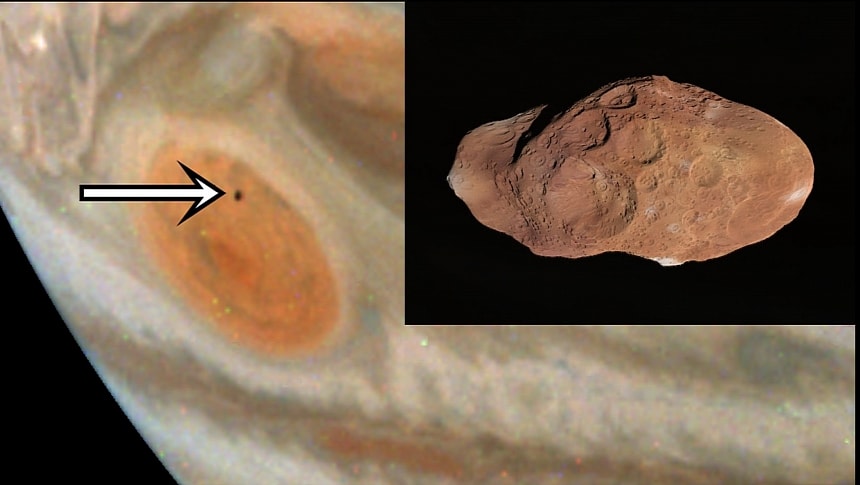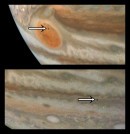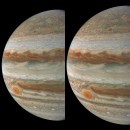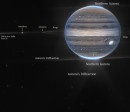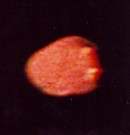Do you sometimes forget the Jupiter has a lot more than a handful of major moons? It's not hard to, considering the media only ever seem to talk about four of them. But recently, a little Jovian moon not of the Galilean family, had a brief but notable flash of the limelight. In front of the awaiting cameras and sensors of NASA's Juno space probe, Amalthea made itself known to the world at large back on Earth.
For some, it's the first time they've ever seen, let alone heard of this little moon barely the size of a small US state in surface area. But as the third closest Jovian satellite in terms of its orbit around Jupiter, Amalthea regularly plays host to some of the most spectacular views in the Solar System, its skyline dominated by the full imposing wrath of its gargantuan home planet. With this considerable gravitational tug in mind, previous observations by cspacecraft, most notably the Galelieo probe back in 2000, deduced that Amalthena likely barely qualifies as a single solid mass we'd conventionally identify as a moon.
Instead, its surface is a loosely amalgamated collection of rock and minerals barely held together by its meager collective gravity. Its surface, later observed to have a Mars-like reddish hue, is thought to be stained by sulfur emissions flung off from the nearby Galilean moon Io. This latest observation by NASA's Juno probe was its first encounter with Amalthea in its continual series of 53-ish-day-long orbital transit around Jupiter, of which the probe has done at least 59 so far. Appearing as little more than a proverbial zit on Jupiter's iconic Great Red Spot, these two photographs prove that Jupiter's inner orbit is a far more inhabited place than you might first realize.
With just 110,000 miles and change (177,027.8 km) separating Amalthea from the upper wisps of Jupiter's thick atmosphere, a significant enough cosmic event in its vicinity might be enough to knock the moon right into a fiery date with its home planet. That said, such close proximity to the toxic and corrosive volcanic emissions from Io might finish Amalthea long before a wayward asteroid or comet comes flying through the area. All the while, tidal forces wrenched upon Almathea by Jupiter's gravity, coupled with fairly intense thermal radiation from its home planet, means the moon emits slightly more heat from inside itself than it receives from the Sun, an almost unheard-of phenomenon outside of the Jovian system.
With so many secrets to unlock occupying such a compact space in Jupiter's orbit, Amalthea's chance encounter with the Juno probe is the perfect segway into greater exposure and, ultimately, a greater public appreciation for non-Galelian moons in general.
Instead, its surface is a loosely amalgamated collection of rock and minerals barely held together by its meager collective gravity. Its surface, later observed to have a Mars-like reddish hue, is thought to be stained by sulfur emissions flung off from the nearby Galilean moon Io. This latest observation by NASA's Juno probe was its first encounter with Amalthea in its continual series of 53-ish-day-long orbital transit around Jupiter, of which the probe has done at least 59 so far. Appearing as little more than a proverbial zit on Jupiter's iconic Great Red Spot, these two photographs prove that Jupiter's inner orbit is a far more inhabited place than you might first realize.
With just 110,000 miles and change (177,027.8 km) separating Amalthea from the upper wisps of Jupiter's thick atmosphere, a significant enough cosmic event in its vicinity might be enough to knock the moon right into a fiery date with its home planet. That said, such close proximity to the toxic and corrosive volcanic emissions from Io might finish Amalthea long before a wayward asteroid or comet comes flying through the area. All the while, tidal forces wrenched upon Almathea by Jupiter's gravity, coupled with fairly intense thermal radiation from its home planet, means the moon emits slightly more heat from inside itself than it receives from the Sun, an almost unheard-of phenomenon outside of the Jovian system.
With so many secrets to unlock occupying such a compact space in Jupiter's orbit, Amalthea's chance encounter with the Juno probe is the perfect segway into greater exposure and, ultimately, a greater public appreciation for non-Galelian moons in general.
